Introduction
First Wi-Fi networks appeared in late 90s and many of us use them ever since. During these years we could observe significant increase of throughput, but what is important, it is not only due to the ISP providing better link. Wi-Fi standard also evolved to keep up with the higher throughputs. If there will be no amendments to the standard, we would stuck with 2-11 Mbps with the wireless link. Such performance would be unacceptable. Therefor, IEEE, which is a major publisher of scientific journals, specifications and organizer of conferences, provides improvements to the standard.
Wi-Fi standard format
Technical name for Wi-Fi standard is IEEE 802.11. This means that IEEE maintains this standard and the series of it is 802. This series covers all kind of local area networks and metropolitan area networks, so not only the wireless. The 802 series consists of working groups (WG). WG 11 deals with wireless local area network (WLAN). Other well known standard in this series is IEEE 802.3 – Ethernet. Additionaly, new amendments improve the standard. We denote them with additional letter after the standard name, i.e. 802.11a, 802.11n or two letters as the set of single letters is not sufficient for IEEE, e.g 802.11ac.
Initial Wi-Fi standards
The first Wi-Fi standard was introduced in 1997. It was considered rather as a beta-specification. If offered too many options and variants, that made interoperability virtually impossible. Then in 1999 two amendments were published: 802.11a and 802.11b. Let’s take a look on what was specified in these standards.
The first standard we will analyze is 802.11b. In the physical layer Direct Sequence Spread Spectrum (DSSS) is used. It operates in ISM band – 2.4GHz and single channel occupies 20MHz. There is no support for any advanced antenna configuration – only single Tx and single Rx. This standard offers only low modulation order – QPSK. All these features provided maximum 11 Mbps of througput.
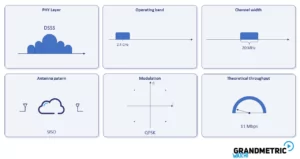
802.11b – features
Although the 802.11a is first in alphabetical order we discuss it after 802.11b. Devices using this technology were introduced to the market after the 802.11b. This was caused by the used band – 5GHz. Technical difficulties in components production for this frequency delayed 802.11a. That’s why 802.11b became more popular and is more familiar. 802.11a used higher modulation order and OFDM, which offered throughput upto 54 Mbps.
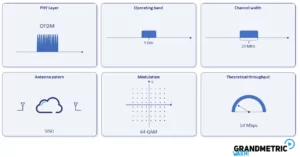
802.11a – features
Then in 2003 802.11g was introduced – it combined features from amendments a and b. It works in 2.4 GHz band, but uses OFDM and 64QAM. This made the device easier to manufacture and therefor cheaper, while providing good performance, since achievable throughput was 54Mbps.
Next important amendment 802.11n brought many novelties. It supported both bands – 2.4 GHz and 5 GHz and allowed to utilize wider bandwidth: 40MHz. It still used OFDM and 64 QAM, but an important feature was introduced in “antenna section”. Devices could use more than one antenna – upto 4 antennas in transmitter and receiver. This increased throughput and robustness. With all these features and some additional improvements devices using 802.11n could reach 600Mbps throughput, which is 10-fold increase compared to previous amendment.
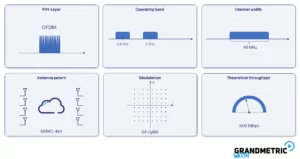
802.11n – features
Latest Wi-Fi standards
In this section we will discuss two of the modern Wi-Fi standards, namely 802.11ac and 802.11ad. They both allow to achieve very high thourghputs reaching nearly 7 Gbps, so again we have 10-fold increase. That is one of few things that these standards have in common. There are more differences between them than similarities. Let’s examine step by step what is used in both amendments:
-
Physical layer
In case of both ac and ad we can use OFDM, but the latter offers also single carrier mode, with additional power saving possibility.
-
Band
802.11ac uses only 5GHz band. It ommits crowded and congested 2.4GHz band. 802.11ad however uses 60GHz band. This band allows to use very wide channels, but we face multiple wave propagation problems like high attenuation, low reflections and almost no penetration.
-
Bandwidth
In comparison to initial Wi-Fi standards 802.11ac allows upto 8-times wider channels – 160MHz. Such wide channel allows to greatly increase througput. As we mentioned before, in 60GHz band, where 802.11ac is operating, there is a lot of space for wide channels. That’s why devices working according to this amendment can use bandwidth of 2160MHz!
-
Antenna pattern
802.11ac extends MIMO capabilities to 8 antennas in transmitter and receiver, but also introduces multi user MIMO (MU-MIMO), which enables transmission to different users simultanously. 802.11ad on the otherhand, takes a step in different direction. Instead of sending multiple data streams, multiple antennas form highly directed beam. This beam targets and follow the device. This helps to deal with the propagation problems a bit, since the wave can travel directly to the user without reflections.
-
Modulation
Thanks to using clear 5GHz band 802.11ac increases the maximum modulation order to 256-QAM. This allows to send 8 bits per symbol. In 802.11ad the modulation order is not changed and equals to 64-QAM.
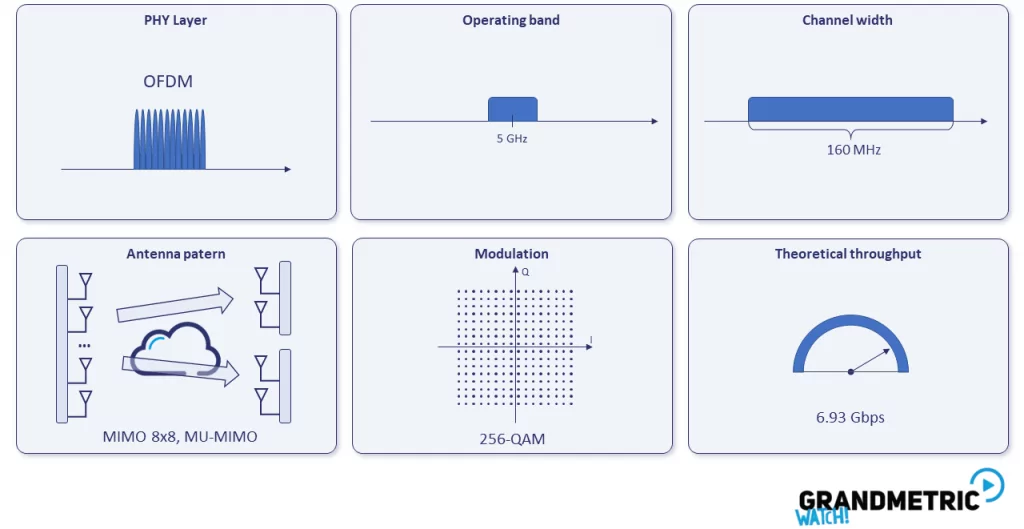
802.11ac – features
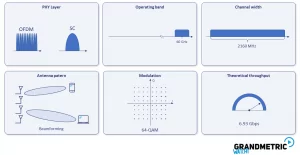
802.11ad – features
Summary
In the table below we gathered discussed amendments with main inforamation about them: frequency band, bandwidth, modulation, MIMO and achievable throughput. As you can see there are a lot of improvements over time, which enable wireless access with a throughput of nearly 7Gbps.
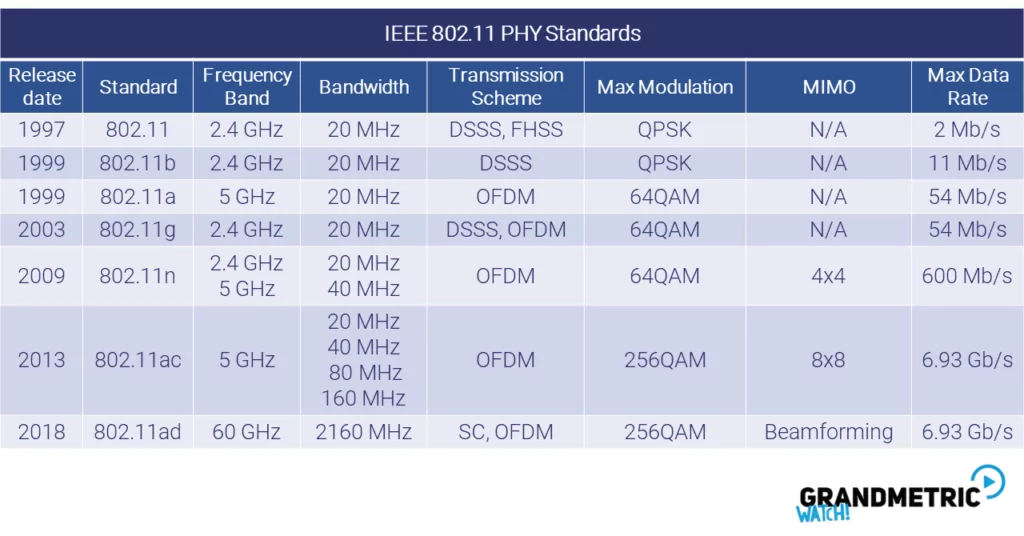
802.11 standards overview
Other materials
To see other posts on network and wireless fundamentals – for example about pathloss, shadowing or MIMO – see our explained section.
To subscribe to our mailing list for our online platform where you can learn all this and more (for example all the details on OFDM transmission) visit GrandmetricWatch.











